Friday, July 31st
My early flight from Taipei to Kyoto wasn’t actually to Kyoto. It was to the nearby, larger Osaka, and the Osaka International Airport, from which you then take a 1-hour train to Kyoto itself. It’s weird that the airport’s official code is KIX, which looks like Kyoto International Airport to me. Why isn’t OIX? There isn’t one of those already, I checked. After poking about a bit, I discovered that this stands for Kansai International Airport, where Kansai is the province containing Osaka and Kyoto. Ok, reasonable enough I guess. Except the airport’s website calls it “Osaka International Airport”, so there’s clearly some mixed signals going on. Look, I’m no more nit-picky than the next guy… (Ha ha, made you laugh there didn’t I? Ok, let me restate: I’m no more nit-picky than anyone else in my circle of friends. That’s better. I’ve seen the nits you people pick, don’t try to deny it!) I’m just saying there are few places where I want everything in perfect order more than when I’m in a giant hunk of metal 30,000 ft above the earth’s surface. Don’t think I’m asking too much here.
Well, not to digress. I landed, did the customs thing again, found the train easily, stood in a substantial line with insufficient air conditioning to get a reserved seat on it, and rode it into Kyoto, where the city was — take a guess — hot and humid. The Airbnb host, Liam, had provided extensive instructions on how to stay at and go to his place, including some info on the bus route, which was probably a 25 minute car trip without traffic and a 45-60 minute bus ride. Google claims it’s only a 33 minute bus ride, but this was a route I took many times during my stay there, and Google lies — probably because that’s a no-traffic estimate and there was always traffic, sometimes a lot of it. Oooo, ancient cultural city. Oooo, temples. Oooo, geisha district. Yeah. Oh, it had those things to be sure, but it’s still a modern city and there’s a downtown with tall buildings and trains and buses and many many traffics. Nearly all of the traffics, so far as I could tell.
Fortunately, having read a little bit about the procedures used for a Kyoto bus, I was ready. I had exact change, I knew the procedure (board through the rear door, pay as you exit through the front door), and I had the bus number thanks to Liam (and Google agreed). The bus circle runs through the train/subway station/mall, and so I found the #5 bus easily, and rode it to the stop next to my Airbnb, which you can see on the Kyoto map below:

Train station near the lower center, Liam’s place at the upper right. Plus some other points of interest that will be described later. (Foreshadowing!)
I should probably say a few words about Kyoto here. It’s considered the cultural center of Japan, and was the capital for 1,000 years before the move to Tokyo in the mid-1800s. Though the wooden buildings burned regularly (think of recurring Chicago Fires), there are many buildings left over from the length of that period, and it avoided the destruction of WWII — not just the atomic bombs but the more normal firebombings like the one that took out half of Tokyo — because one of the local scholars wrote to the U.S. administration asking it to be spared as a cultural center, and the U.S. did. (Yay, us!) So, while many of the “historic” buildings in Japan’s major cities aren’t originals and were rebuilt after the war, Kyoto’s survived, and the city has 1600 temples and 400 shrines. According to one of my tour guides, its primary industry is tourism, it’s the most visited city in Japan, and it has an annual tourist count equal to that of New York City. Which has to be considered impressive by any standard.
I had picked Liam’s Airbnb for 2 reasons: (1) while it wasn’t super cheap, it was at the low end for the Kyoto area, and (2) it was on the side of town with a bunch of shrines and whatnot, right next to something called the Philosopher’s Walk. As I’d seen it described, the Walk sounded like a walkway next to a river with a bunch of shrines and shops and cafes along it, and sounded perfect for having snacks and nice things to drink while sitting in a moderately comfortable cafe chair watching the river and the pedestrians, and reading a book. In fact, while the bit before the “sounded perfect” part was technically true, everything was scaled down from what I was expecting. It was a well maintained trail, running beside a creek, in a neighborhood with some shrines/restaurants/cafes/shops, but not really a lot of them and not any places to sit out and enjoy nibblies while reading and enjoying the view.
Can I just say how much I love Japanese cicadas? I used to hear them in anime shows set in summer months, and they always took me back to where I lived in Texas, where the cicadas were an enduring feature of the summer and early fall. Gods I hated those thing? Different cicada species have different drones, and the Texas ones were patterned, a sort of throbbing buzz ramping up in faster and faster cycles until they hit a high-pitched buzz-saw noise that went on for 10 seconds or so before stopping, and then starting all over again. If they’d stayed monotone, you could ignore them, but that cyclical variance could be maddening.
Of course, time passes, you move away, and you start to feel some nostalgia for it, tempered by the memory of how much you hated it at the time. And then the Japanese cicadas come along and give you all of the warm fuzzies, but none of the annoyance. The basic sound is the same, but the cyclical ramp up is gone. Love them. Anyway, back to the Walk.
I did spend some time one day reading in a cafe while enjoying a poorly designed iced coffee with too much ice, an overpriced grilled cheese sandwich, a slice of overhyped apple cake, and air conditioning, but that was pretty much the closest the reality of the Walk approached my expectation.
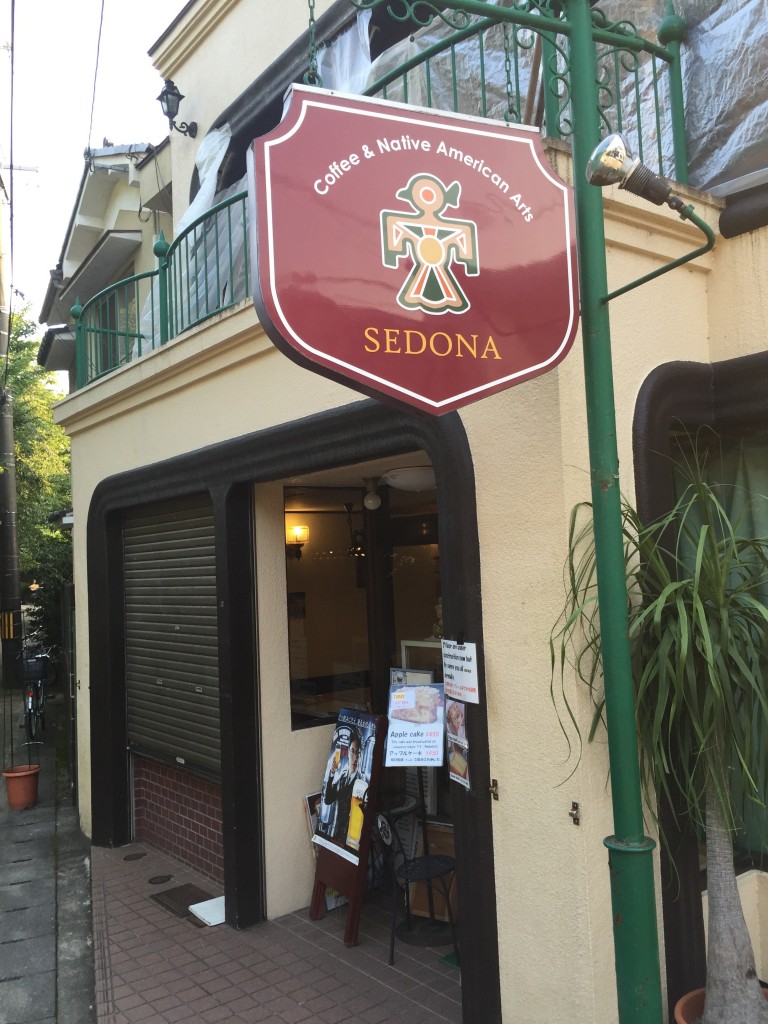
The incongruously named Sedona cafe. (The connection to the real Sedona, other than the signage, was invisible to me.) As you can see from one of the signs, the adequate apple cake was billed as “broadcasted on Japanese Major TV”. This is probably similar to how every book that gets a screen adaptation acquires the blurb “Now a Major Motion Picture”, no matter how small the production, how limited the release, or how minor the talent. Given how much the Japanese value their desserts, and how merely Ok the cake was, I suspect the that event was probably better described as “mentioned on cable access television”.
I don’t really mean to rag on the Walk, it was quite pretty. Shady trees (desperately needed), koi fish in the creek…. Prettier still, I’m sure, in cooler temperatures or during cherry blossom season. Just not what I was hoping for. It was the Niagara Falls of Philosopher’s Walks. (This is going to be my new term for everything that doesn’t live up to its hype. “It was the Niagara Falls of Skytrees. It was the Niagara Falls of Stonehenges. It was the Niagara Falls of Parthenons.” Every enduring cynical hero has a catchphrase, this can be mine.)
[Side note: it amazing how absorbing soap operas are. My host, Kenta, has Japanese soap opera on in the background, and I’m trying to write this blog while my attention keeps getting pulled away to the TV. Yes, the attractive young man leaving his attractive female cop friend a video-taped expose about police corruption is surely dead by now, but he’s so sincere, and he clearly loves her. But she has a child, and maybe a husband. Their love would never have worked, and they knew it.]
[Also, when her boss got killed by gangsters, I totally knew it was going to happen, as soon as I saw him have to wait for the elevator to arrive. Ok, I’m going to force myself to look away now. Even though the medical examiner is also really cute. I wish Kenta would put on baseball, I can ignore that. ]
So, Liam’s place was a 3 story building with 2 wings, of which he seemed to rent out a significant part. He’s a freelance computer games designer from Liverpool, who also records music, and named the string of small guest rooms on the 2nd floor with musical notes instead of numbers. I was in the “Mi” room, a fact that I’m sure my friends will find as amusingly appropriate as I did. It was set up like a kind of hostel, with a bunch of small rooms with a bed and a dresser and (thankfully) in-room A/C, and a common sink area, toilet room, shower room, and shower/tub room. Downstairs had the common room / kitchen, and some rooms that were Liam’s living area, record space, and computer office (often shared with one or more friends/employees). I think he rented out a couple more rooms up on the 3rd floor, and the building’s owner may have been renting out others for other purposes. There was also a roof with a decent little view of the valley that the neighborhood was in, a washing machine and clotheslines, and, by the day after my arrival, a large table and benches. The Airbnb page has a bunch of pictures, but this is a short video I took from the roof one morning:
After a few days of staying at Liam’s, I took to coming up here every morning to eat breakfast (one or more of Japanese omelette, yogurt, sushi, and canned coffee from the market a few blocks away). It was really nice before the heat of the day kicked in. The sun would rise over the mountain to the right, and I’d block it with the clothes on the clothesline, or with a tarp if there were no clothes, and just eat and read and meditate. It was my favorite part of the day — and lovely in and of itself, not just with respect to the hellscape of heat and humidity that followed.
BTW, speaking of nice places to sit and read: the book du jour is Jon Scalzi’s Old Man’s War.
I’ve been hearing about Scalzi for a few years, as a popular hard-SF writer with a string of winning books under his belt. This was his debut novel, and he wrote several sequels to it, as well as a couple of other series. I’ve read other writings of his on the net, and he’s always seemed sharp, funny, and a really nice guy — and there’s a whole mini-group of right-wing serious nutjobs in the SF world (the ones who were responsible for the recent Hugo Awards nonsense) who seem to hate him with a passion, for the usual nonsense reasons that people who hate on the internet have, which predisposes me to like him. So I bought the first of his books and, hardly surprisingly, found it very enjoyable.
As the title suggests, it’s military SF — the Amazon link I included above has a very effective introductory description, so I won’t write my own here. What I will say was that I found it surprisingly emotional for a military SF book. Not excessively so, but there were a few moments in there that got to me very effectively. The angle of your soldiers being senior citizens put an interestingly different spin on it — there wasn’t the usual “kids in the army” stuff where no one is prepared and everything is overwhelming and you have to grow and mature and become the military SF equivalent of the Chosen One with Wisdom Beyond Your Years. These are adults. Their maturing has already happened, they know what the military is basically going to be like even if they were never in it (as we all do), and they’re either going to be good and survive or they’re not and they’ll die. (Or they’ll be good and die in battle anyway.) So, the book had a calmer pragmatism to it that I really liked. On the downsides: there was one bit of conversation that rang false to me — a minor thing in the overall book, but it stood out glaringly. And the pacing seemed a little uneven, with a lot of setup and then a faster rush to the end. In fairness, that’s kind of hard to avoid when you have to start a book by world-building, your characters are more complex than young adults (you can start any magical orphan’s story in a few paragraphs, or a chapter at the outside), and you want to avoid writing a weighty tome that will discourage casual readers. Presumably, this then pays off in the sequels when your characters are established and you need less world-building; I enjoyed this well enough as a standalone book, so I’m definitely looking forward to reading more of them.
So, the ostensible raison d’être of this blog out of the way, let’s get back to Kyoto. I mentioned my host earlier, Liam, whom I met shortly after arriving; he’s a nice guy in his 30s, who seemed well on his way to comfortable dissipation. He was fairly chatty, and though we weren’t quite in sync we were close enough to have a few decent conversations. He had a party the evening of the day after I arrived, and I helped haul a rather large amount of stuff to the rooftop on my own, including 3 rather heavy wood benches for the table that he and a coworker wrangled up the stairs. (For game developers, they had a very poor sense of spatial relationships, judging by their challenges getting that giant table up the 3 flights of narrow stairwell.) I got to meet a lot of folks that Liam works with and their SOs, many of them Western couples in their late 20s / early 30s making not nearly enough money in Japan but trying to make a go of it anyway because they like it there. It was generally entertaining conversation for a couple of hours, but by around 8:00 I’d had enough sake and was looking at having to push into a new conversational group if I wanted to stay longer, so I called it a night.
I feel like I’m describing Kyoto by event and by random association, and getting it all out of order. I’m not sure why this one is all over the map, and you probably don’t care, but I was in Kyoto for 10 days and I’m going to try to bring some semblance of order to the rest of this. So, Friday, I arrived, walked the Philosopher’s Walk, talked the Philosopher’s Talk with Liam, picked up dinner at the 7/11, and went to bed.
Saturday, August 1st
As this is August 1st, I should mention that this week was pretty much the 6-month milestone week of my travels. I left New York at the end of January, so end of July, start of August, I was thinking a lot about the year so far and was starting to see the remainder as a kind of countdown to my mid-November return to the states. Now, in a sense, I was no longer going away; I was returning, however circuitously. I’d like to say I had some sort of epiphany around about now, about my true nature or ways that I’ve grown or whatever, but no, not really. I have started to feel like this isn’t an unknown experiment anymore, that I know basically what I’m doing and how to do it. And that who I am hasn’t really changed, despite changing everything around me; I was never that dependent on my situation or circumstances, but it’s interesting to see how little they mattered to me. They were just things that I did — job, home, city, stuff, they were needed, I did them, usually enjoyed them, but was never particularly attached. Now I do different things. Wouldn’t mind seeing more of my friends — the problem with being a well-balanced hermit is that sometimes you want company, and it’s nice to have that option. Being alone in foreign countries, that’s not really there as much as I’d like. But it’s still me, coasting through the world around me. Seeing that affirmed has been the closest to an epiphany I’ve had in this process, fresh confirmation of what I’ve always known about myself. Perhaps there will be a more unexpected realization as I return to the states. Or after. We shall see. 🙂
So, Saturday I ran up against the hard truth that I hadn’t really prepped for this leg of the trip: I had a place to stay, but I hadn’t set up any tours to go on yet. So Saturday I mostly hung at at home, browsed tour options, and scheduled things. On the plus side, I got to relax from the 2 weeks of Tokyo/Taipei and surrounding travel, and enjoy air conditioning for the day. And I walked further along the Philosopher’s Walk in the late morning, and ate at that Sedona cafe that I described above. And this was the day with the rooftop party. On the minus side, all the Viator tours seemed to have a lead time of several days before I could book them, so Tuesday (8/4) was the first one I could do, and it was a little tough to do more than a very few without doing a tour a day for the remaining days until I left (on 8/10), and that didn’t appeal to me. Also on the minus side, and this one hurt: there were a number of sake brewery tours, but nearly all of them insisted on 2 or more people per booking. This was the same problem I’d had in Taipei, at the Jiufen tea house, and it seemed harshly unfair to the solo traveler. In theory, I could have booked as two people, paid double the price, and gone on my own anyway, but it offends me morally that I should have to. (Well, it mostly offends my wallet, which has a larger voice in dictating my morals now than it did a year ago. I’m almost Republican now, in my unwillingness to spend money in a good cause. Almost, as in, “Not really but it amused me to say.” Which you probably knew.)
Anyway, after some hours of searching and playing with dates and times, I found 4 tours that sounded appealing, including the one brewery tour that would take me. And then I was helping set up for the party, buying snacks and sake to contribute that were quite out of proportion to what I ended up eating (or had intended to eat), moving furniture and food to the roof, and retreating periodically to my room to sit in the A/C. And, lest you should be starting to think of me as a total wuss about the weather, everyone in Kyoto was complaining about it. Kyoto is apparently in a sort of bowl, enclosed on 3 sides by mountains, and the weather gets quite cold in the winter and really hot in the summer (not uncommon in Japan generally), and this year was unusually hot even for them. This seems to be a recurring theme everywhere I’m going, and I expect that will only get worse in my travels in the years ahead. Which reminds me: I should make a point to visit low-lying areas now, before the sea levels rise and make them inaccessible. Hello, Holland!
Sunday, August 2nd
Thankfully, I’d gone to bed a bit early the night before — not that early, for me, but I’d specifically not stayed up for the whole party on the roof. I woke at my usual sunrise-ish time, came downstairs on my way to 7/11 to buy breakfast, and found the kitchen a mess, someone sleeping under the kitchen table, and my orange juice in the fridge missing, almost certainly converted into screwdrivers the night before. (Liam had come up with little refrigerator bins for each room, but they weren’t large, and you can’t really lie a carton of oj on its side in a bin once it’s been opened. So anything I put in there that wouldn’t fit in the bin was at risk of someone else eating it. I lost about half a shopping trip of salad veggies that way. Yay, impermanence!)
At around 9, I walked down towards a pair of museum not too far away: you’ll see them on the map a little to the southwest of Liam’s place; the Google map marker shows one museum, but there are actually 2 across the street from each other, and a giant Torii gate over the street between them.
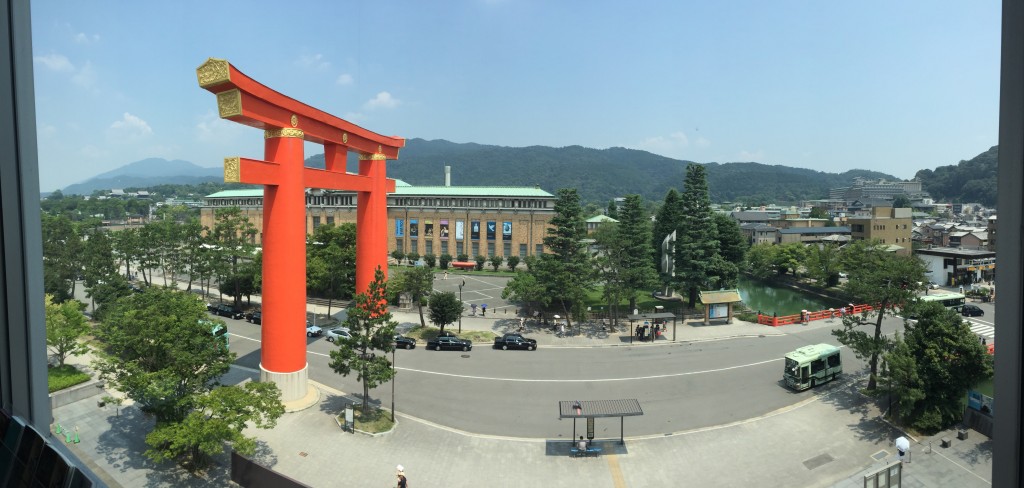
A pano of the “Kyoto Municipal Museum of Art”, taken from the 2nd floor of what I presume is its bitter rival, the “National Museum of Art, Kyoto”. I’ve said before that I’d love to live in a place where you encounter spontaneous street festivals when you’re just walking around, and the same applies to giant Torii gates. The closest thing to a fun cultural milestone that you randomly encounter in the U.S. is people in animal costumes twirling signs for condo sales, and it’s just not the same thing.
It was about a 20 minute walk to the museums, and there were vending machines with cold coffee outside, so I sat and had coffee and a snack and watched the rather pretty canal flowing next to them before going in.
The first one, on the east side of the street, was (and probably still is) the Kyoto Municipal Museum of Art, which had exhibits on Magritte and on the Louvre. The Magritte exhibit had a lot of really nice pieces of Magritte’s, and was intensely frustrating to me. I found a piece that I really liked, that had a cool quote from Magritte about it, and I wanted to look up more information on the quote later, and I started to write it down on my iPhone — not take a picture, mind you, just write some words. A woman immediately appeared at my side making gestures to indicate that I couldn’t do that. Ok, fine. I pulled out a pen and started to write on my palm, and Oh No that was not allowed either! This seemed rather incomprehensible to me, and I tried to gesture, basically, “See, no phone!” But she summoned a young guy who spoke at least a couple of words of English, and he insisted on giving me a museum brochure and a tiny, tiny, pencil — really, a pencil lead attached to a toothpick-sized plastic stylus — to do my writing with. I think this must be fairly common in Japanese museums, because I’ve seen it in a couple of other places since. But damned if I understand the rationale. Are they terrified that I’ll take my pen and start drawing on the museum walls? Is a pencil the only thing they think they can safely allow me to use? Jesus, Japanese people, unclench!
I gritted my teeth behind my smile, and even wrote down whatever the quote was with the tiny pencil on the large brochure. But, of course, the brochure vanished sometime over the next week, and I have no idea what the quote I wanted to look up was, now. Meanwhile, my iPhone still has a record of everything else I noted in it from that trip, without wasting a large brochure to capture a single sentence. Sigh.
This put me in a bit of a mood for the rest of that exhibit, but I enjoyed the art at least. Then I went across the building to the Louvre exhibit, and that was packed, with slow lines filing their way past the usual Renaissance European art that most of us are used to seeing in art museums anywhere. You know the stuff: Belgians sitting around tables arguing against dark backdrops, overdressed ladies sitting in chairs, Greek gods enacting mythological scenes in Florentine garb. Interesting enough, but no way I was standing in slow moving lines where anything I really did want to look at closely would carry the implied weight of a few hundred Japanese people backed up behind me. Especially not since I was taller than they were, and could just walk along the outside of the line and look over their heads at the paintings. Thankfully, after the first room, things opened out a bit, the lines weren’t quite as defined, and I was a little more free to go where I liked.
When I was done with that, I went up to the second floor, but there appeared to be some sort of gatekeepers at the north and south wings up there, and I didn’t feel like dealing with them. Plus, I could see those room were filled with calligraphy — giant scrolls of Kanji writing that I wouldn’t be able to read or appreciate properly. So I left. But I did read that the Kyoto Municipal Museum of Art is the 2nd largest art museum in Japan, and even taking those unviewed 2nd floor rooms into account I have to conclude that the other museums must not be art museums, because the place wasn’t really that big. Granted, I may be spoiled by U.S. museums, which are often very large and amazing, and they won’t all be The Met, but still. Not overwhelmed.
From there, I walked across the street to the National Museum of Art, Kyoto (part of a chain of National Museums, apparently), and had a much nicer time. They had an exhibit of Japanese tableware by a famous artist (“Kitaoji Rosanjin: A Revolutionary in the Art of Japanese Cuisine”) — not the sort of thing I rush to see, and I’m always amused by the sort of insular artistic viewpoints that turn “He made plates that were pretty and different” into “A Revolutionary in the Art of Japanese Cuisine”, but it was interesting nonetheless. They had a large room full of movie posters from American musicals, which was weird and amusing. And a level with a general selection of old and new Japanese art that I remember enjoying though I couldn’t tell you much about it now. And no one hassled me about anything, so way better than that little provincial “Municipal Museum”.
By the time I was done here it was pushing 1:00 and I was starving. Plus, I wanted to head south (heat be damned) to a couple of Buddhist temples that weren’t far away. Thankfully, just south across the canal was a 7/11, and I picked up a little bag of smoked salmon and some Pocari Sweat. (I may have mentioned that before: Pocari are tiny mountain goats in the Japanese highlands, and their sweat is considered very healthy. Or maybe it’s an sports drink like Gatorade. One of those.) I sat outside the 7/11 and ate them, along with a bunch of other museum goers, and tried not to start sweating so soon after leaving the museum’s air conditioning. It was a futile effort.
From there I headed south down a street, with little traditional shops and eateries along its length, to the Shoren-in Buddhist temple which was a really nice wandering building set amongst decorative, sculpted, pine trees and stone lanterns, and other Buddhisty gardeny things.

Spoiler: I was only here once, but this became my favorite place in Kyoto. Would love to come back when it isn’t sweltering.
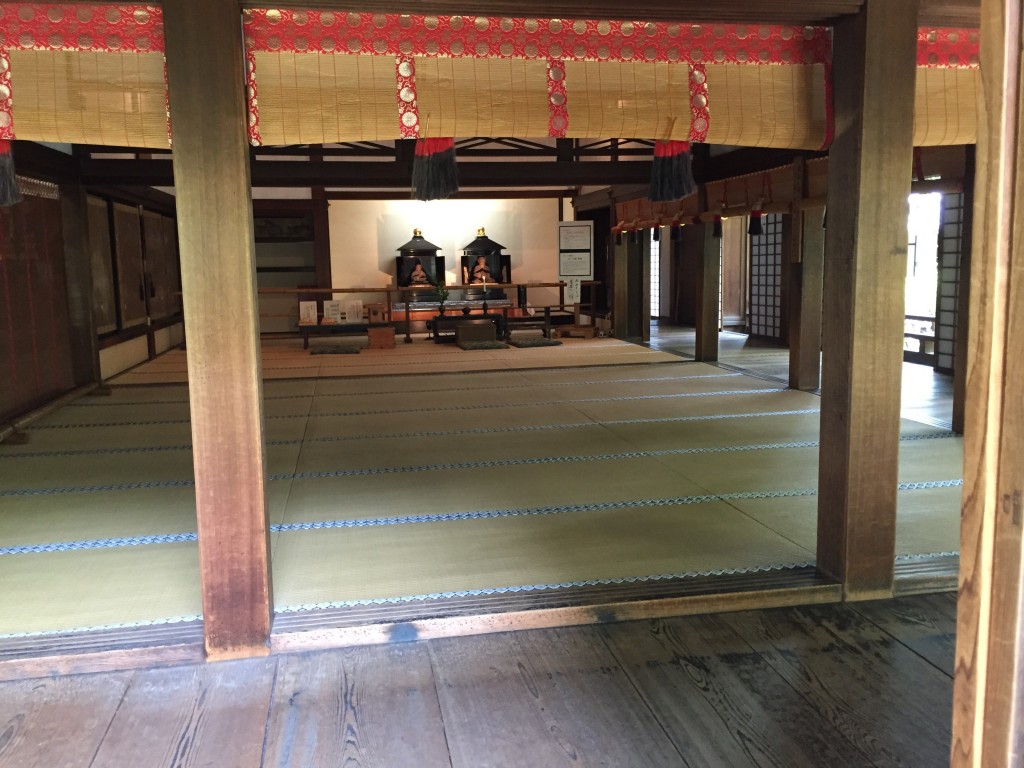
It’s a working temple, by which I mean that there are actual monks who pray here when tourists aren’t about. When the tourists are here, they pretend to be statues. Don’t feed them after midnight.
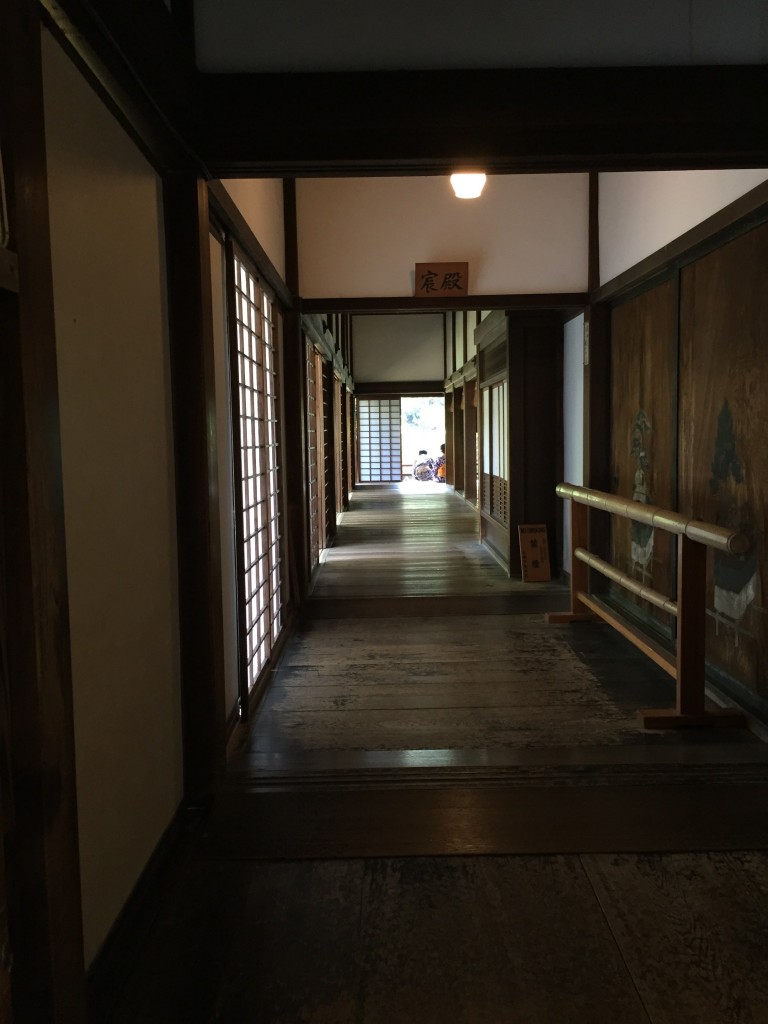
I really like the dark woods of this outer hallway. And this also shows a young guy and a girl in traditional clothing sitting at the edge of the hallway, looking out at a branch of the garden. I later learned that this is a fairly common thing to do on dates in Kyoto; you rent traditional outfits (and this may become rather elaborate for the woman, with wigs and makeup), and go places and hang out in costume. Again, wish we did that. Imagine: you’re out on the Promenade and there are couples in Jane Austen clothing hanging out and looking sharp. How cool would that be? Super cool, that’s how cool.

There was a large corner room with people sitting in it and even picnicking. I took up a seat facing out, with my back to one of these posts, and meditated for a while. It was really nice. (This would be an amazing place to come and sit and read when it was raining.)
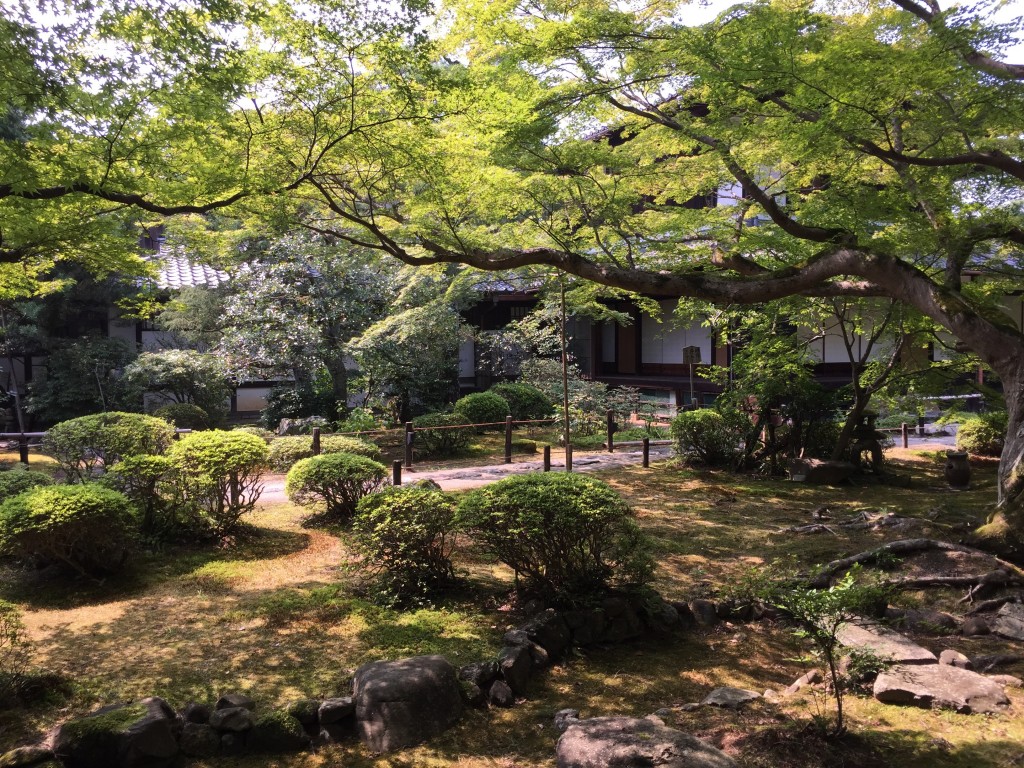
The grounds were once larger, but I read that some parts were seized by the Tokagawa Shogunate quite a while ago, (those bastards) and are now part of the Chion-In Temple to the south. Shoren-In seems to have kept the good bits, though.
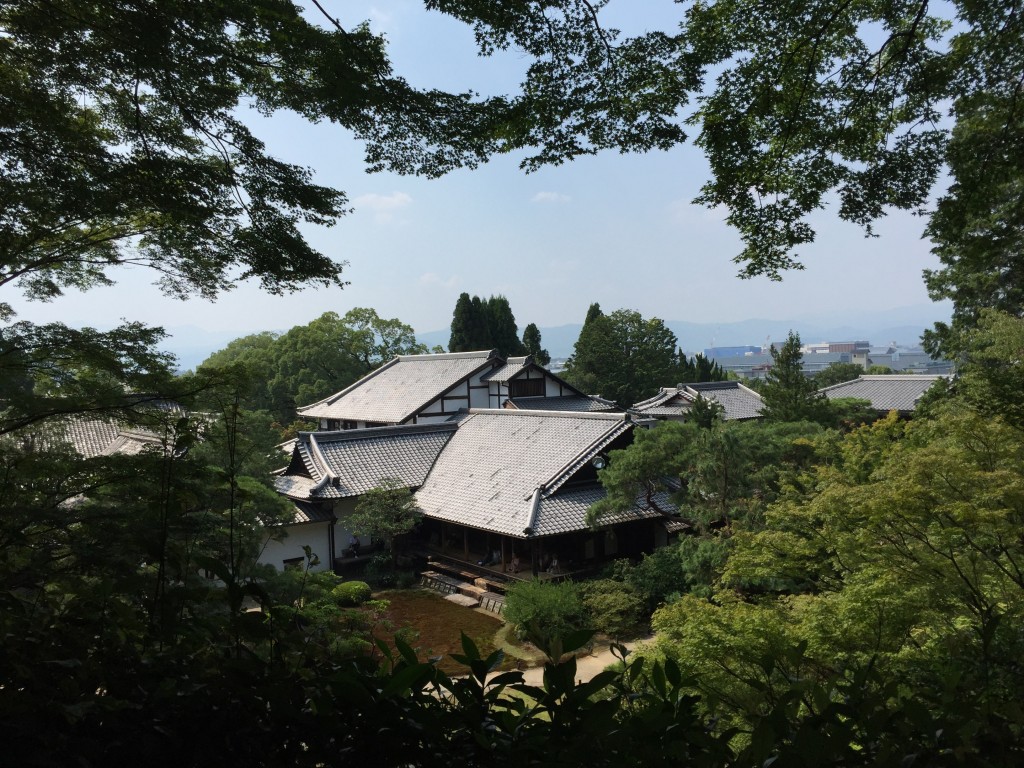
A picture from up the hill path. You can see where I was sitting, though I must have left already ’cause I don’t see me there.
I had another picture of a larger garden bit on the side of the building, but the afternoon sun kind of washed the picture out, and it’s a fairly large download, so I’m going to skip it. So, here are a bunch more to make up for it. Many of them are quite pretty, so I can recommend the click. Go ahead, I’ll wait.
For those of you who didn’t click, let’s keep going, and make the others run to catch up. Oh, how we’ll laugh! So, after a while in this temple, I headed down the street to the next one, the Chion-In Temple, which was used as the home of the feudal lord in The Last Samurai.
Look, I’m kind of at odds on what to do here. I took some pictures, but some parts of the place were closed for maintenance, and it was near closing time (4:30-ish), and, honestly, I was not in love with the place. Choin-In is a temple for Pure Land Buddhism, a popular variety of Buddhism in Asia that, to my mind, is the anti-Buddhism. It’s principle is, basically, “You’re too far down to dig your way out by your own effort, but pray repeatedly to the Amitabha Buddha and he will grant you good karma and you can escape the cycle of death and rebirth.” So, basically, it’s a Buddhist variant on “Pray to the Good Lord Jesus and he’ll save you.” If you’re into Buddhism because the enlightenment path appeals to you, this is pretty much the reverse.
I don’t want to be too hard on it; it’s just a layman’s branch of Buddhism. In truth, every religion divides up into one or more layman’s branches and one or more gnostic branches. The gnostic branches are for people who want to Know the Divine, directly apprehend their spiritual nature and that of the universe around them. It requires a great deal of effort and commitment, you have to want it. Most people don’t have that temperament. They’re laymen. They have a normal life, work, family, etc, and they want their religion to give them a general context for their existence that they can feel secure in, a set of guidelines for how to behave and how to deal with their fellows (and to constrain how their fellows deal with them), and some sort of being to talk to and ask for help when they need it. When I was younger, I thought that gnostics were right and laymen were misguided, and now I take a more Myers-Briggs approach and say look, everyone’s different and you should find the path that suits your nature. But every religion has these aspects, expressions of differing human natures. Judaism has Reform Jews and Hassidim. Islam has its main religion and then it has the Sufi mystics. Christianity worked rigorously to stamp out any dissent and its branches are pretty exclusively lay religions, but still gnostics and Christian mystics cropped up with regularity (Hildegard von Bingen, The Cloud of Unknowing, etc). Hinduism values both branches, coexisting in one philosophy, and you’re expected to become more gnostic as you get older.
Anyway, 2-penny lecture aside, despite my general “Yeah, whatever” I get just as itchy in a Pure Land context as I do in a Christian church. It’s not my thing, man, and the groveling aspect bugs me. So, combine that with the under-construction aspect of the place, and the frankly rather uninteresting grounds, and I was not a fan. But here are some more pictures, if you want them. I did buy a nice ice cream in the gift shop and eat it there, so that was a plus. And they were selling what was clearly salad dressing, which I bought a bottle of rather eagerly. I’m not sure what made it special to the temple, but I have been unable to spot salad dressing in Asian markets, so I normally use yogurt instead. It works surprisingly well, but it was awesome to have a proper sesame honey dressing on my next few salads. So the temple wasn’t a total loss.
After this, I walked home, picked up some groceries at a local market — including salad fixings, yay! And sat in the A/C in my room watching vids and reading Twitter until I bedtime.
And I’ve gone on long enough, so this is probably a good place to end off. I’ll wrap up Kyoto in a part 2.

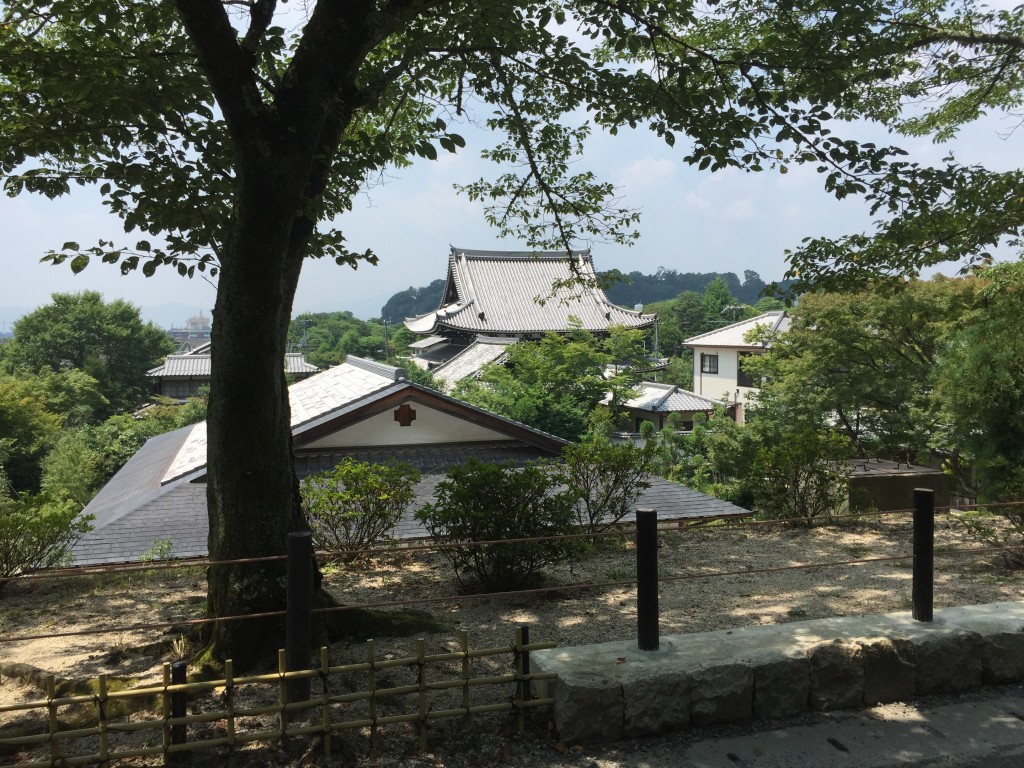

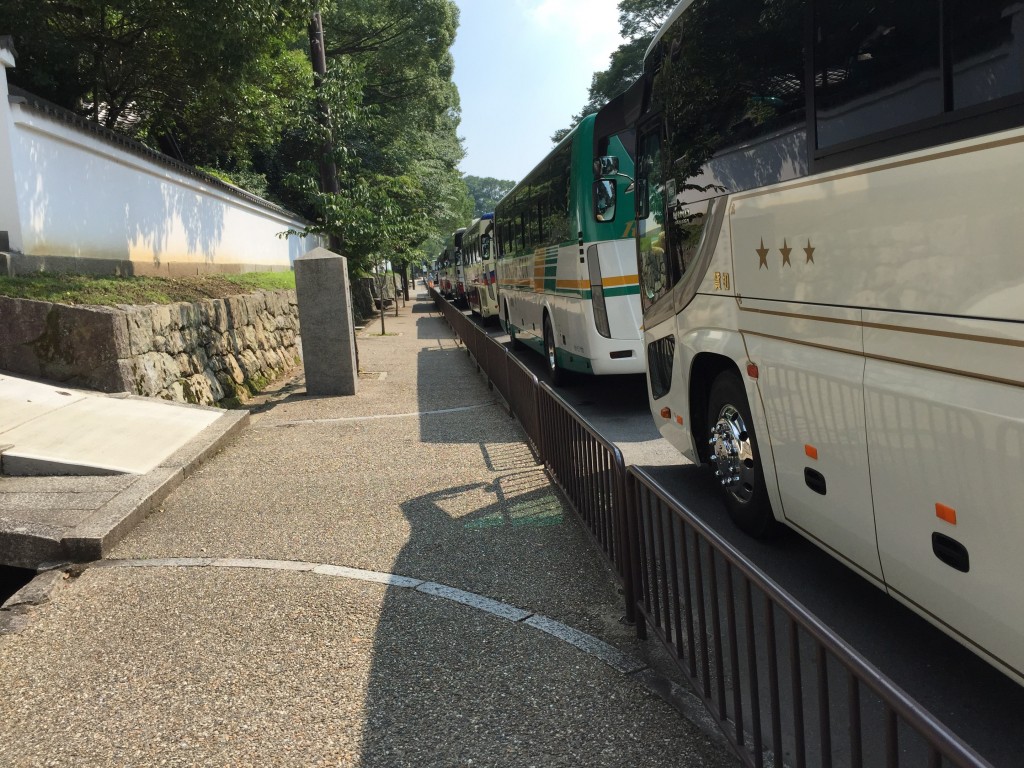
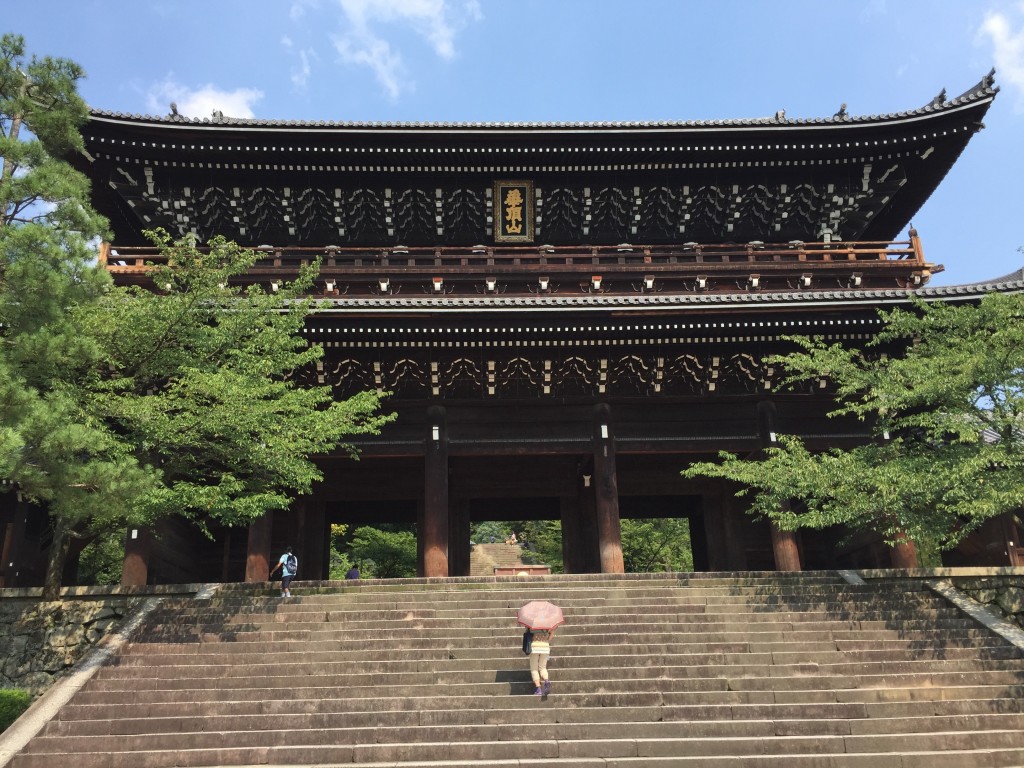
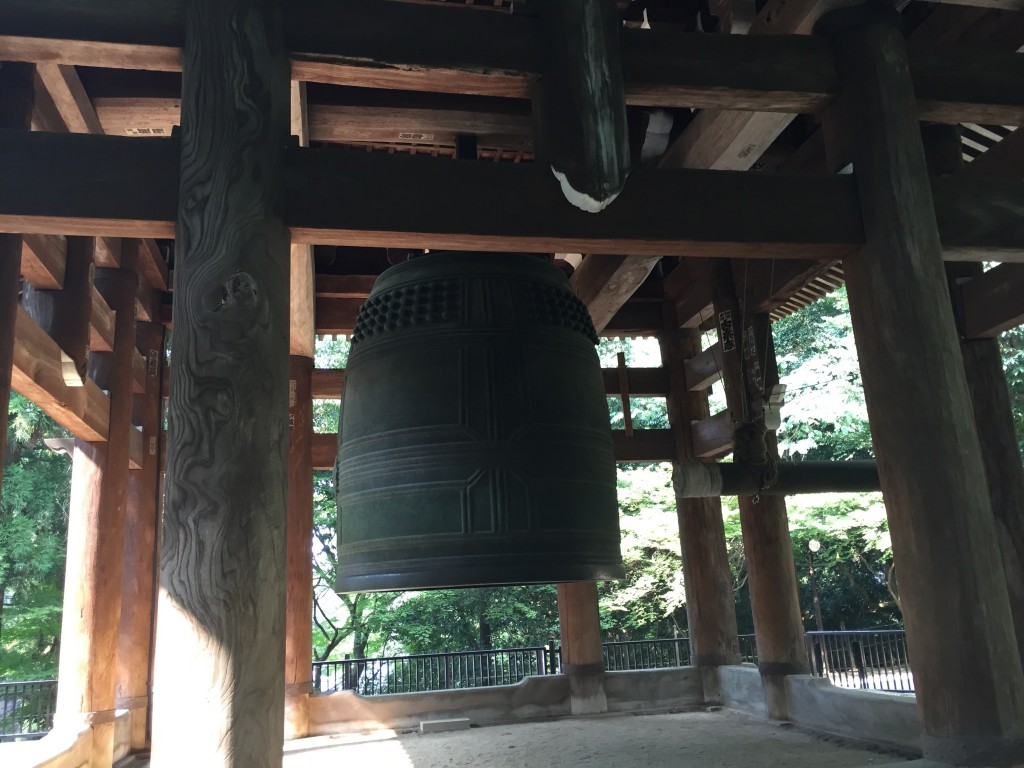
Loved the pics of the Shoren-in Temple – I can see why it was your fav. This is really getting off the point, but I started to wonder if they have mosquitoes…….
They do, but not many. I think I got one bite in Kyoto, and I don’t remember if I ever actually saw one. Sapporo didn’t seem to have any the first 6 weeks I was here. Then just after I got back from Kyoto, we moved into autumn here, it got a bit rainy, and I’d find a few in the wettest part of the park I like to go to. But they haven’t been a big hassle, and it’s waaaaay better than southern Thailand was.